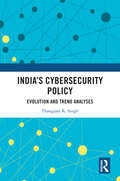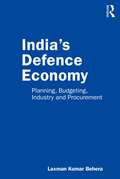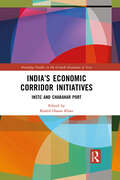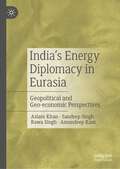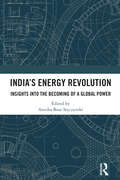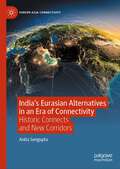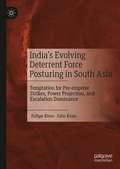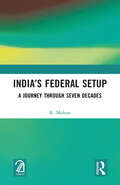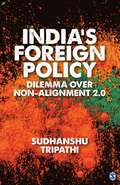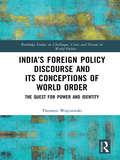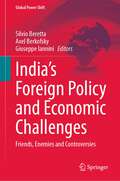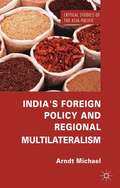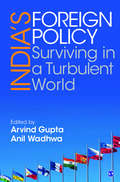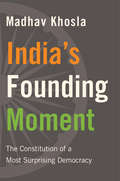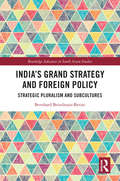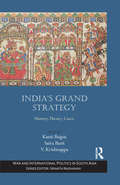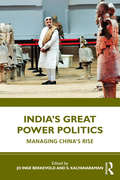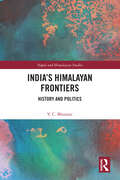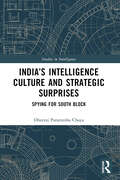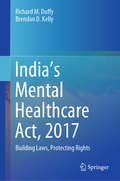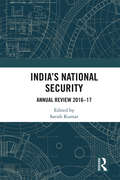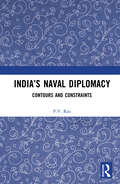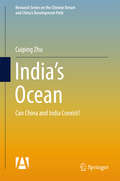- Table View
- List View
India’s Cybersecurity Policy: Evolution and Trend Analyses
by Thangjam K. SinghThis book examines India’s public policies on cybersecurity and their evolution over the past few decades. It shows how threats and vulnerabilities in the domain have forced nation-states to introduce new policies to protect digital ecosystems. It charts the process of securitisation of cyberspace by the international system from the end of the 20th century to the present day. It also explores how the domain has become of strategic interest for many states and the international bodies which eventually developed norms and policies to secure the domain.Consequently, the book discusses the evolution of cybersecurity policy at global level by great powers, middle powers, and states of concern and compares them with the Indian context. It also highlights the requirement of introducing/improving new cybersecurity guidelines to efficiently deal with emerging technologies such as 5G, Artificial Intelligence (AI), Big Data (BD), Blockchain, Internet of Things (IoT), and cryptocurrency.The book will be of great interest to scholars and researchers of cybersecurity, public policy, politics, and South Asian studies.
India’s Defence Economy: Planning, Budgeting, Industry and Procurement
by Laxman Kumar BeheraAs the fourth largest military spender in the world, India has a huge defence economy supported by a budget amounting to nearly $67 billion in 2020–21. This book examines how well India’s defence economy is managed, through a detailed statistical exposition of five key themes – defence planning, expenditure, arms production, procurement and offsets. This book is based on hard-core evidence collected from multiple government and other credible sources including the ministries of Defence, Finance, and Commerce and Industry, Comptroller and Auditor General of India and the Reserve Bank of India. It discusses key issues such as the evolution of India’s defence plan; the feasibility of increasing defence spending; India’s defence acquisition system; and the recent reform measures taken under the rubric of the ‘Make in India’ initiative. Well supplemented with original tables and figures, India’s Defence Economy will be indispensable to students and researchers of defence and security studies, politics and international relations, finance, development studies, economics, strategic studies, South Asian politics, foreign policy and peace studies. It will also be of interest to defence ministry officials, senior armed forces personnel, military attachés, defence training institutes and strategic think tanks.
India’s Eastward Engagement: From Antiquity to Act East Policy
by Rahul Mishra S.D. MuniIndia’s Eastward Engagement: From Antiquity to Act East Policy presents India’s engagement with its extended eastern neighbours from ancient times to the present. It argues that this engagement has been long rooted in India’s geographical location, its civilizational evolution and historical transformations. The book critically examines all the important phases—Nehru and Post-Nehru periods, and Look East and Act East policies. It exposes the widely entertained myths about India’s eastward engagement and also underlines the prospective directions in which the Act East Policy may unfold in the years to come.
India’s Economic Corridor Initiatives: INSTC and Chabahar Port (Routledge Studies in the Growth Economies of Asia)
by Kashif Hasan KhanIndia’s Economic Corridor Initiatives highlights key aspects of current discourses on India’s initiative of the International North-South Transport Corridor (INSTC) and Chabahar, and their geo-economic significance.INSTC was founded by India, Russia, and Iran, and the Chabahar port in Iran provides a major prospective conduit for India's interchange and commerce with West Central Asia while maintaining a strategic distance from Pakistan's entry route. This book analyses the drastic changes in the equation of international relations in general, and more particularly between India and Eurasian countries. Contributors from Iran, Central Asia, Russia, Armenia and Europe provide a wide spectrum of opinion and analysis on the subject. The chapters claim that these corridors provide an alternative to the BRI and can play a pivotal role in de-escalating tensions through negotiations.A new addition to the debate on contemporary dynamics in Eurasia and India, this book will be of interest to researchers studying economic corridors, transnational and trans-regional economic relationships, security studies, regional and area studies, international relations and Indo-Iran-Russia relations.
India’s Energy Diplomacy in Eurasia: Geopolitical and Geo-economic Perspectives
by Sandeep Singh Amandeep Kaur Bawa Singh Aslam KhanThis book provides an accurate evaluation of re-integration of Eurasia in the context of India’s energy security and diplomacy which requires a normative shift as in the current Eurasian geopolitical and geo-economic matrix, the growing role of transit countries and their proximity with the Energy Complex Zone negates the fact that great powers or strong states control the Eurasian Heartland. Authors believe that wrecking this norm is fundamental here to deconstruct the undercurrents of energy geopolitics prevailing in Eurasia over the emerging phenomenon, as it discourages the re-integration of the Eurasian region. It explores how the geopolitical struggle between major powers for energy resources has been engendering mutual interdependencies between energy producers and transit countries. It makes an attempt to provide a transcontinental study of Eurasian energy and connectivity as a thrust area for the present work positioning Eurasia in Indian foreign policy, determining the contours of energy diplomacy in connection with the Eurasian energy policy. It defines Eurasia broadly as the region that encompasses Central Asia and the Caucasus including Russia and transit countries. It addresses the geopolitical and geo-economic aspects of Eurasian re-integration in the context of India’s energy security. The objective of this book is to combine theoretical, contemporary, and policy-oriented issues that deserve scholarly attention and would both complement and supplement the academic contributions.
India’s Energy Revolution: Insights into the Becoming of a Global Power
by Annika Bose StyczynskiIndia is the third-largest emitter of greenhouse gases, which makes it an important player whose climate mitigation actions and inactions are closely scrutinised. This book studies developments in India’s energy system from a governance perspective. It presents a unique compilation and synthesis of research findings that capture achievements, shortcomings, and persistent and transient challenges of India’s transition towards a net-zero economy by 2070.The book grounds its analysis in domestically formulated goals and reflects on dynamics at the structural level of India’s multi-scalar innovation system, by highlighting the influencing factors of energy system status and change. It presents the perspectives and positions of different actor groups, studies the market and business, and discusses cases influenced by existing or changing institutions across the whole spectrum of energy resources from fossil to non-fossil fuels and respective technologies.The volume will be useful for students and researchers in energy governance, energy policy and economics, socio-technical transition studies, energy systems engineering, sustainable development, and environmental studies. It will also be of interest to policymakers and investors.
India’s Eurasian Alternatives in an Era of Connectivity: Historic Connects and New Corridors (Europe-Asia Connectivity)
by Anita SenguptaThe volume examines how in the twenty-first century narratives built around connectivity have become a structural component of international politics expanding into a wider array of policy fields i It examines the significance of this emerging narrative from an Indian perspective with particular reference to Eurasian alternatives. It argues that this represents the next stage of globalization and that an understanding of this is increasingly becoming crucial given the recent disruptions along with the emergence of a spate of new policies and institutions that could eventually lead to a new understanding of connectivity.
India’s Evolving Deterrent Force Posturing in South Asia: Temptation for Pre-emptive Strikes, Power Projection, and Escalation Dominance
by Zafar Khan Zulfqar KhanThe book discusses India’s evolving deterrent force posturing in South Asia under the conceptual essentials of nuclear revolution when it comes to various combinations of conventional and nuclear forces development and the strategic implications it intentionally or unintentionally poses for the South Asian region. The book talks about how the contemporary restructuring of India’s deterrent force posture affects India’s nuclear strategy, in general, and how this in turn could affect the policies of its adversaries: China and Pakistan, in particular.Authors discuss the motivations of such posturing that broadly covers India’s restructuring of its Nuclear Draft Doctrine (DND), the ballistic missile development program, including that of its Ballistic Missile Defence (BMD) system, and the possibility of conflicts between China-India and India-Pakistan, given their transforming strategic force postures and their recurring adversarial behavior against each other in the Southern Asian region.
India’s Federal Setup: A Journey Through Seven Decades
by R. MohanThis book analyzes the evolution of our polity in the last seven decades by examining the developments in the economy, political events, and changing judicial perceptions. With a focus on the pertinent constitutional, political, economic, and social questions, it presents an overview of events which have influenced the evolution of federal and unitary tendencies.The subject matter of this book also discusses the emergence of coalition governments, dominance of a single party, relationships between the different tiers of the government, fiscal and economic issues, and political actions of constitutional authorities.Print edition not for sale in South Asia (India, Sri Lanka, Nepal, Bangladesh, Pakistan or Bhutan)
India’s Foreign Policy Dilemma over Non-Alignment 2.0
by Sudhanshu TripathiIndia’s Foreign Policy Dilemma over Non-Alignment 2.0 presents the story of India’s quest for renewed focus on the doctrine of Non-Alignment. It begins with a discussion on the evolution of India’s Foreign Policy along with the origin of its most important pillar, Non-Alignment, and its cumulative effect in India and abroad. It further discusses challenges, compulsions and constraints for India’s Foreign Policy in context of the current instability and insecurity due to mounting Chinese and Pakistani collusion against India’s rising profile in Asia, the emerging Pyongyang–Beijing–Moscow axis against the US, the evolving US–China bipolar world order in the background of eastward shifting geopolitics, economic recession and terrorism. The book argues that it is incumbent upon India to take a fresh lead today to reinvent the doctrine not only for its own national interests but also for the entire Third World. It proposes various steps to revitalize India’s Foreign Policy so that India can play a desired role in the present global order.
India’s Foreign Policy Discourse and its Conceptions of World Order: The Quest for Power and Identity (Routledge Studies on Challenges, Crises and Dissent in World Politics)
by Thorsten WojczewskiGiven India’s growing power and aspirations in world politics, there has been increasing interest among practitioners and scholars of international relations (IR) in how India views the world. This book offers the first systematic investigation of the world order models in India’s foreign policy discourse. By examining how the signifier ‘world order’ is endowed with meaning in the discourse, it moves beyond Western-centric IR and sheds light on how a state located outside the Western ‘core’ conceptualizes world order. Drawing on poststructuralism and discourse theory, the book proposes a novel analytical framework for studying foreign policy discourses and understanding the changes and continuities in India’s post-cold war foreign policy. It shows that foreign policy and world order have been crucial sites for the (re)production of India’s identity by drawing a political frontier between the Self and a set of Others and placing India into a system of differences that constitutes ‘what India is’. This text will be of key interest to scholars and students of Indian foreign policy, foreign policy analysis, South Asian studies, IR and IR theory, international political thought and global order studies.
India’s Foreign Policy and Economic Challenges: Friends, Enemies and Controversies (Global Power Shift)
by Silvio Beretta Axel Berkofsky Giuseppe IanniniThis book provides a state-of-the-art analysis of India’s foreign and security policies, examining e.g. the country’s security, economic and trade ties and interactions with Pakistan, China, the United States, Japan, the Middle East and ASEAN. Furthermore, the contributors provide the reader with an overview and analysis of the quality and challenges of India’s regional and global trade and investment policies. While in the past India has been a reluctant and not particularly prominent foreign and security policy actor in East and Southeast Asia as well as globally, China’s resurgence and its assertive and increasingly aggressive regional security policies have led India’s policymakers to reconsider the country’s decades-old non-alignment policies and opt for expanding security and defence ties with the United States, Japan and others. The Indian-Chinese border clashes in 2020 and China’s unlawful occupation of disputed territories along the Indian-Chinese border in the Himalayas have convinced Delhi’s policymakers and the country’s security and defence elites that India is well advised to join and contribute to US-led China containment policies. The expansion of India’s security and defence ties with Japan over recent years in particular will continue to be instrumental to keeping Beijing’s territorial expansionism in Southeast and South Asia in check. This volume analyses India’s involvement and engagement in regional and global trade and investment structures and flows in great detail. Written by a team of prolific European and Indian scholars, the book will be of interest to researchers in the fields of international relations and security studies, as well as policymakers at governmental or international organizations.
India’s Foreign Policy and Regional Multilateralism
by Arndt MichaelThe book provides a novel analytical perspective on regional multilateralism in South Asia and its neighbouring regions and covers the genesis, evolution and status quo of the four major regional organizations.
India’s Foreign Policy: Surviving in a Turbulent World
by Arvind Gupta Anil WadhwaWritten by foreign policy experts, academics and practioners, this book develops the frameworks and strategies for India’s foreign policy that can be adopted to meet the emerging challenges and non-traditional threats in the new world order. It studies the important aspects of India’s foreign policy in the present unsettled world order and comes up with strategies and policy suggestions. It raises several questions to highlight the future direction of foreign policy and the challenges that India may have to deal with in the coming years. The book covers the domestic dimension of the country’s foreign policy, which is often missed out in policy discussion. It examines the close link between national security and foreign policy, and shows how foreign policy can be leveraged to strengthen the economy and make India a hub of innovation. This book emphasizes soft power strategies to ensure that a strategic approach to soft power projection is adopted. India’s Foreign Policy: Surviving in a Turbulent World is a ready reference on India’s foreign policy that can be used to understand the complexities of the topics covered.
India’s Founding Moment: The Constitution of a Most Surprising Democracy
by Madhav KhoslaMadhav Khosla describes the remarkable work of the founders of independent India. All at once they built a democratic system in the midst of illiteracy and poverty enforced by a century of imperial domination and neglect. They crafted a constitution aimed at creating democratic citizens through democratic politics.
India’s Grand Strategy and Foreign Policy: Strategic Pluralism and Subcultures (Routledge Advances in South Asian Studies #39)
by Bernhard Beitelmair-BeriniThe book explores the competing grand strategic worldviews shaping India’s foreign and security policies by analyzing the interaction between normative modern international relations theories and vernacular concepts of statecraft and strategy. To assess the diverse competing ideas which characterize India’s debates on grand strategy and foreign policy, the author presents the subculture-cleavage model of grand strategic thought. This innovative analytical framework reveals the complexities of India’s strategic pluralism and offers the building blocks for a systematic analysis of grand strategy formation. The book demonstrates that the strategic paradigms, or strategic subcultures, are marked by contending ideas of Indian statehood and civilization, held by policymakers and the informed public, and are a result of ideology-driven perceptions of the country’s strategic environment. The author argues that the apparent hybridization and stretching of modern and traditional concepts of international relations in India has become a widespread feature of Indian foreign policy to meet the needs of state formation and nation-building. A unique approach to organizing and understanding the debates and discourse in Indian strategic thinking, the book will be of interest to specialists and students in the field of International Relations, political theory, South Asian Studies, and India’s foreign and security policy.
India’s Grand Strategy: History, Theory, Cases (War and International Politics in South Asia)
by Kanti Bajpai Saira Basit V. KrishnappaAs India prepares to take its place in shaping the course of an ‘Asian century’, there are increasing debates about its ‘grand strategy’ and its role in a future world order. This timely and topical book presents a range of historical and contemporary interpretations and case studies on the theme. Drawing upon rich and diverse narratives that have informed India’s strategic discourse, security and foreign policy, it charts a new agenda for strategic thinking on postcolonial India from a non-Western perspective. Comprehensive and insightful, the work will prove indispensable to those in defence and strategic studies, foreign policy, political science, and modern Indian history. It will also interest policy-makers, think-tanks and diplomats.
India’s Great Power Politics: Managing China’s Rise
by Jo Inge Bekkevold; S. KalyanaramanThis book examines India’s foreign and defence policy changes in response to China’s growing economic and military power and increased footprint across the Indo-Pacific. It further explores India’s role in the rivalry between China and the United States. The book looks at the strategic importance of the Indian Ocean Region in the Indo-Pacific geopolitical landscape and how India is managing China’s rise by combining economic cooperation with a wide set of balancing strategies. The authors in this book critically analyse the various tools of Indian foreign policy, including defence posture, security alignments, and soft power diplomacy, among others, and discuss the future trajectory of India’s foreign policy and the factors which will determine the balance of power in the region and the potential risks involved. The book provides detailed insights into the multifaceted and complex relationship between India and China and will be of great interest to researchers and students of international relations, Asian studies, political science, and economics. It will also be useful for policymakers, journalists, and think tanks interested in the India–China relationship.
India’s Himalayan Frontiers: History and Politics (Nepal and Himalayan Studies)
by Viney C. BhutaniThis book looks at the historical and political dynamics of the Sino-Indian border dispute in India’s Himalayan Frontiers. Going back into Tibetan history, the author examines the making of the McMahon Line at Simla Conference of 1913–14. It also takes a look at some of the neighbouring areas that had interaction with Tibet, as well as the border areas of Assam and Burma, both of which were British Indian provinces. By using new archival materials, this study further goes to consider the events during the years following the defining of the McMahon Line, which, verily, did not have a sound juridical basis even if it has been regarded by scholars as a suitable boundary. It further explores different aspects of the northern frontiers of India and Sino-Indian border dispute and relations. This volume will interest scholars and researchers of history, political science and area studies, especially those interested in the geopolitics of India, China and the Himalayan region.
India’s Intelligence Culture and Strategic Surprises: Spying for South Block (Studies in Intelligence)
by Dheeraj Paramesha ChayaThis book examines India’s foreign intelligence culture and strategic surprises in the 20th century. The work looks at whether there is a distinct way in which India ‘thinks about’ and ‘does’ intelligence, and, by extension, whether this affects the prospects of it being surprised. Drawing on a combination of archival data, secondary source information and interviews with members of the Indian security and intelligence community, the book provides a comprehensive analysis of the evolution of Indian intelligence culture from the ancient period to colonial times and, subsequently, the post-colonial era. This evolutionary culture has played a significant role in explaining the India’s foreign intelligence failure during the occurrences of strategic surprises, such as the 1962 Sino-Indian War and the 1999 Kargil War, while it successfully prepared for surprise attacks like Operation Chenghiz Khan by Pakistan in 1971. The result is that the book argues that the strategic culture of a nation and its interplay with intelligence organisations and operations is important to understanding the conditions for intelligence failures and strategic surprises. This book will be of much interest to students of intelligence studies, strategic studies, Asian politics and International Relations.
India’s Mental Healthcare Act, 2017: Building Laws, Protecting Rights
by Brendan D. Kelly Richard M. DuffyThis book comprehensively discusses the background to the passing of India's revolutionary Mental Healthcare Act, 2017, offering a detailed description of the Act itself and a rigorous analysis in the context of the CRPD and the World Health Organization (WHO) standards for mental health law. It examines the fine balance, between complying with the CRPD while still delivering practical, humane, and implementable legislation. It explores how this legislation was shaped by the WHO standards and provides insights into areas where the Indian legislators deviated from these guidelines and why. Taking India as an example, it highlights what is possible in other low- and middle-income countries. Further it covers key issues in mental health, identifying potential competing interests and exploring the difficulties and limitations of international guidelines.The book is a valuable resource for psychiatrists, nurses, social workers, non-governmental organizations and all mental healthcare workers in India and anyone studying human rights law.
India’s National Security: Annual Review 2012
by Satish KumarThe twelfth volume in the series India’s National Security: Annual Review offers a detailed analysis of India’s complex security environment: persistence of major threats, alongside a constructive engagement with major powers based on its economic growth, military power and political stability. Topping the list of India’s external security concerns is China’s veiled hostility, manifest in its strategic nexus with Pakistan, incursions into India’s borders and enhanced military deployment in India’s immediate neighbourhood. Added to these are the intractable boundary dispute and uncertain implications of the recent leadership change in China. India, nevertheless, is attempting to cope with China’s pressures by engaging with it at a diplomatic level and improving its own defence capability. Pakistan remains another major threat, because of its refusal to take action against militants responsible for the 2008 Mumbai terror attacks, its efforts at expanding its nuclear arsenal, and the increasing sway of right-wing elements on its society, politics and security forces. India further faces the challenges of facilitating Nepal’s difficult transition to democracy, safeguarding its strategic interests in Afghanistan, stabilising Maldives’ fledgling democracy, and tackling ethnic insurgencies along its borders with Myanmar. On the other hand, there are positives like India’s strategic partnerships with Russia, US, France, Britain, Germany, and Japan, as well as a flowering relationship with Bangladesh. India’s internal security situation is less alarming, with progress in talks with some North-Eastern insurgent outfits; a sharp fall in casualties due to left-wing extremism (LWE); and a gradual reduction in terrorist-related incidents in Kashmir. But sporadic cross-border infiltrations in Kashmir and spread of LWE to urban areas still pose challenges. Addressing such and other issues, this book will be indispensable for policymakers and governmental organisations; those in defence and strategic sectors; and students of defence studies, foreign policy, international relations, and political science.
India’s National Security: Annual Review 2016-17
by Satish KumarThe global security environment in the last five years has been characterised by a state of ‘no war, no peace’ among major powers, resulting in a state of uncertainty about their national security objectives. For instance, the US has been concerned about the attitudes of Iran, Russia, North Korea, China, and others, and yet did not expect a direct military conflict with them. On the other hand, China has expanded its naval strategy from a mere ‘off-shore defence’ to ‘open seas protection’ and has called for both ‘defence and offence’ instead of merely ‘territorial air defence’, thereby indicating preparedness for the possibility of a military confrontation. The major powers have been thus groping for suitable responses to their threat perceptions. It is in this kind of a complex and confusing international environment that India, as a rising power, has been called upon to wade through its strategic partnerships with major powers and nurture friendships with various Asian and African countries. This sixteenth volume of India’s National Security Annual Review offers indispensable information and evaluation on matters pertaining to national security. It undertakes a thorough analysis of the trends to provide a backdrop to India’s engagement with various countries. The volume also discusses persisting threats from China and Pakistan. With contributions from experts from the fields of diplomacy, academia, and civil and military services, the book will be one of the most dependable sources of analyses for scholars of international relations, foreign policy, defence and strategic studies, and political science, and practitioners alike.
India’s Naval Diplomacy: Contours and Constraints
by P.V. RaoThis book studies India’s evolving naval engagements with other nations of the Indian Ocean region. It traces the growth of the Indian Navy and discusses its role as an instrument of meeting national objectives, particularly for furthering foreign policy. The volume analyses themes such as Indian Navy’s (IN) transition from a brown water to blue water force, Indian maritime debates and doctrines, naval ‘bridge-building’ missions, and Sino-Indian maritime competitions. It examines Indian Navy’s regional roles within the broader framework of its diplomatic objectives in particular regions and looks at how keen regional states are to accept India as a crisis manager and would allow it to build a regional maritime security architecture. The author also discusses state control over naval diplomatic roles and investigates if Indian Navy can effectively hedge extra-regional, mainly Chinese, involvement in the Indian Ocean. An important study of India’s naval prowess, this book will be indispensable to students and researchers of political science, international relations, maritime and naval studies, strategic studies, geopolitics, defence studies, conflict studies, diplomacy, Indian Ocean studies, South Asian studies and those interested in India-China maritime rivalry.
India’s Ocean
by Cuiping ZhuThis book focuses on international relations in the Indian Ocean region and covers many policy aspects of Modi's India. Written by leading scholars of international and Indian Ocean studies, this annual report includes both a strategic review and the major events and related data in this region. It also discusses the origin, aims, frameworks and regional and global impact of India's development under the Modi administration, offering readers a full and authentic picture of the most recent developments in India. This year's Annual Report is the fourth of this kind and the only one to include the Indian Ocean region of China.
